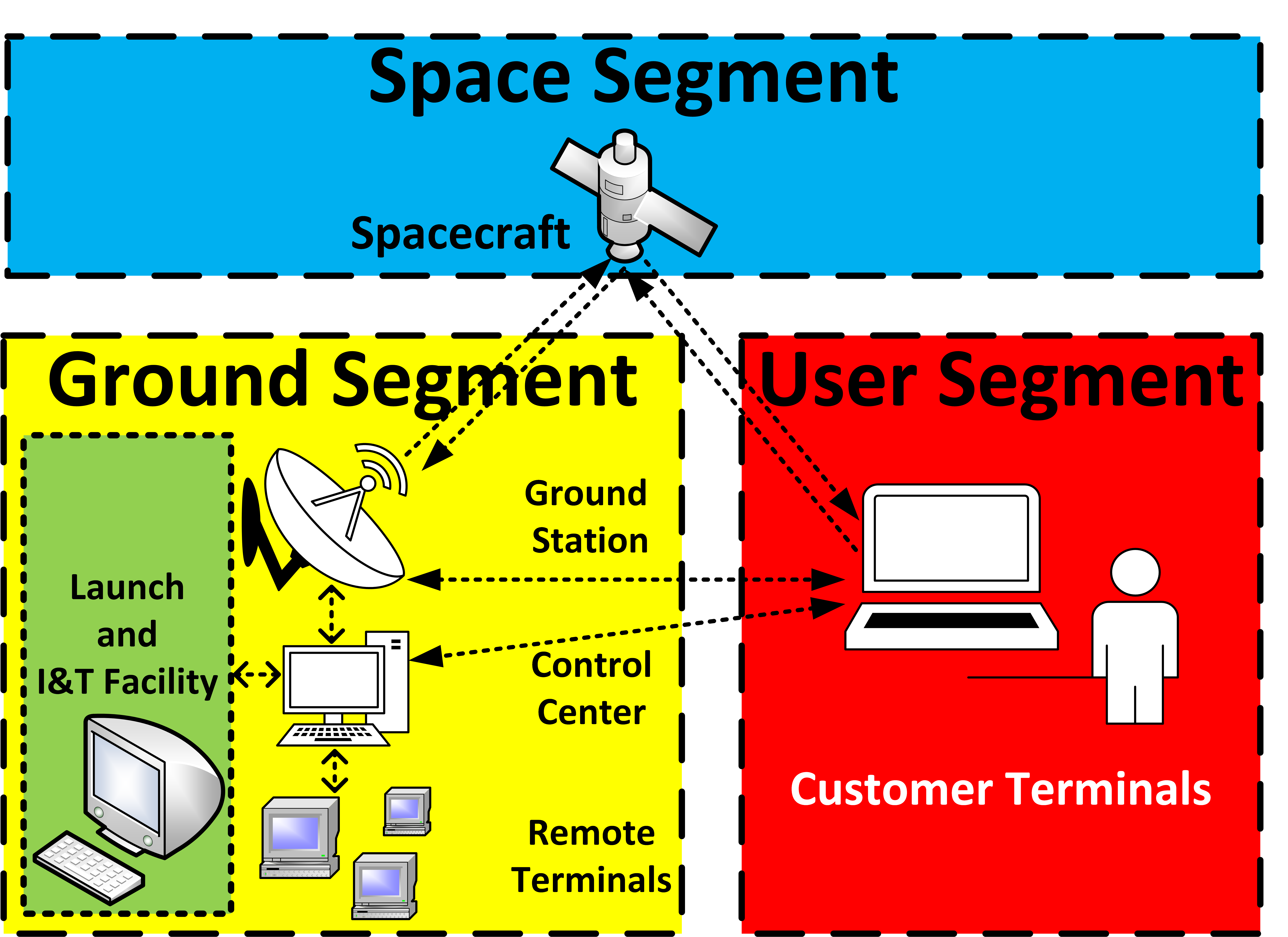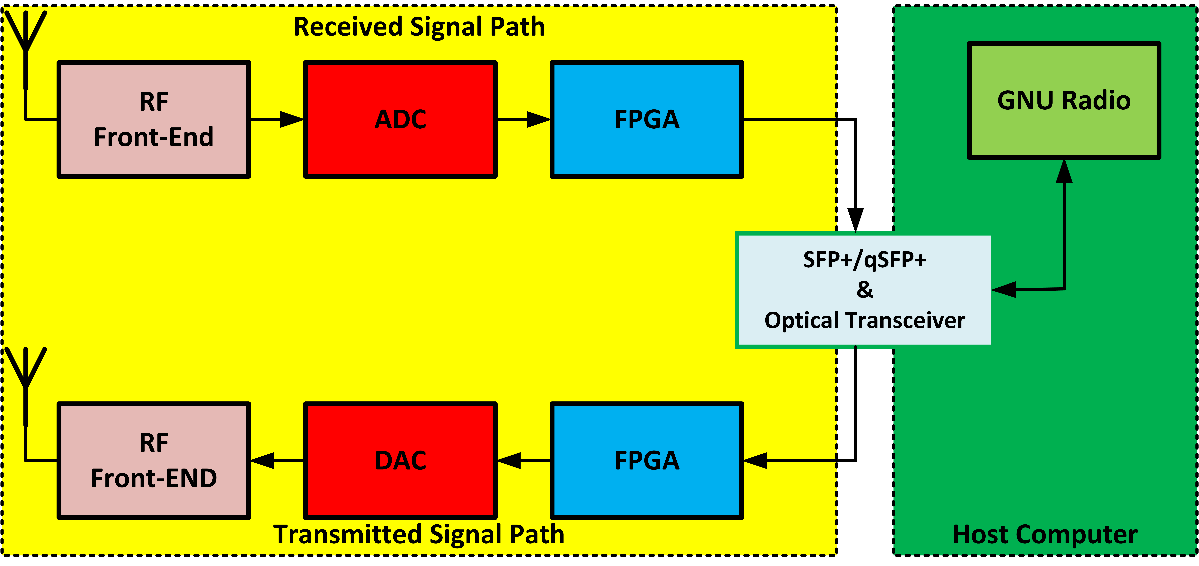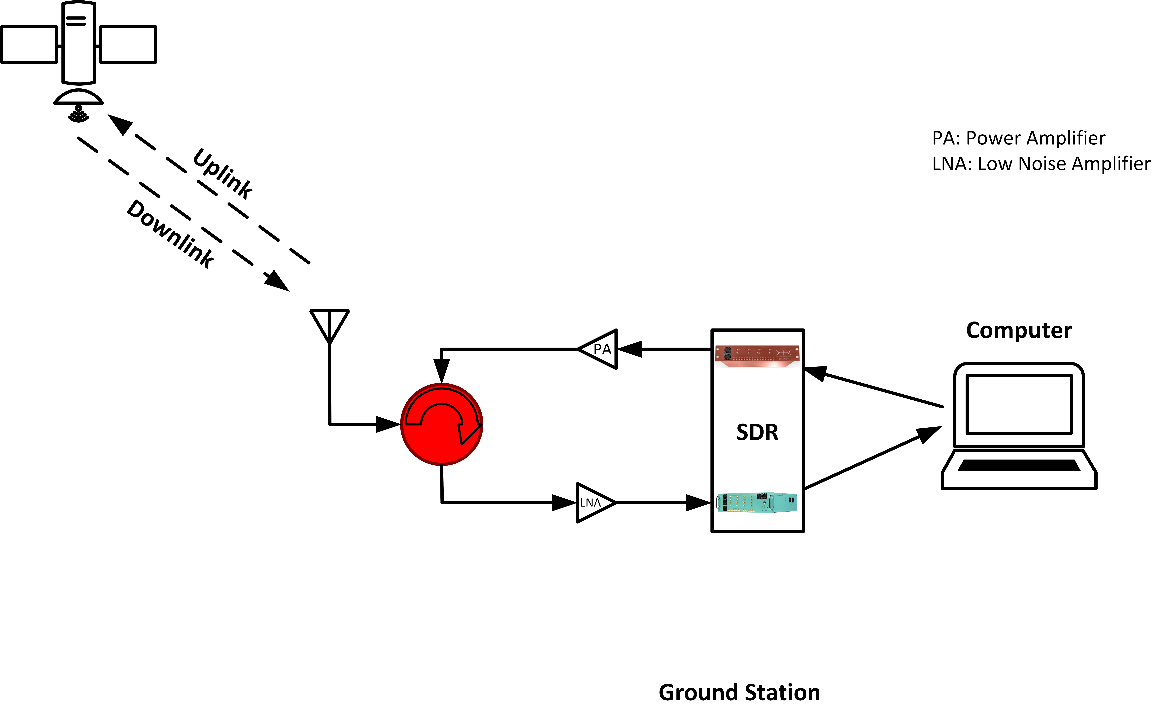Software Defined Radio (SDR) for Prototyping Satellite Ground Stations
Immense testing of the communication systems onboard a satellite and the associated ground station is required before deployment in order to ensure proper reliable operation in adverse conditions. These tests can be performed using software-defined radios (SDRs) as they provide a platform to build reconfigurable, lightweight communication systems that can be quickly modified to include new features and compatibility with emerging protocol standards1.
In this article, we will discuss the types of testing of the radio frequency (RF) communications required during the pre-launch of a satellite. This involves developing and testing the tracking-telemetry and control (TT&C) signals, as well as the modulation and demodulation schemes used for transferring the various data uplinks and downlinks between the ground station and the satellite in orbit. SDR is a powerful platform for testing and prototyping modulation and demodulation schemes for satellites and ground stations since development can be done on low-latency field programmable gate arrays (FPGAs). Through the use of APIs, SDRs allow for a means to test beamforming in emulation environments, prototyping pulse shaping, as well as testing host system requirements needed for processing, passing data to a subsystem, and various other tasks. This enables the development teams to explore different algorithm options, evaluate design trade-offs, and optimize system parameters.
Basics Of A Ground Station
Ground stations control the satellites operation and are designed for collecting and steaming data. Ground stations are mostly antennas that transform data from orbiting spacecraft into actionable reports for satellite and human spaceflight operators. For starters, a ground station is used to maneuver satellites, such as nanosatellites found in a rocket payload, into their orbits that form constellations. Once in orbit, ground stations require the ability to receive and send data with SDRs when in line-of-sight (LOS) of multiple satellites for their positioning, controlling, and monitoring. The ground station equipment can be controlled and monitored remotely through IP and/or serial interfaces. They can provide uplink and downlink communication between the satellite and the ground, including issuing commands or uploading computer programs to the satellite, based on modulating and demodulating signals with an SDR, enabling the operators to securely communicate with the corresponding satellite from the ground.
The general diagram of a simplified spacecraft system is shown in Figure 1 and is comprised of space, ground, and user segments. As opposed to the space section and user segment, the ground segment includes all the ground-based components of a spacecraft system utilized by support staff and operators2. Hence, a spacecraft's payload data and telemetry can be sent to interested parties on the ground through the ground segment. A ground station consists of an antenna (parabolic dish), feed horn, waveguide, power amplifiers, and most often these days, an SDR transceiver. Some antennas are covered with a radome or a giant protective dome, and the application determines the ground station antenna size. Satellite ground stations play a crucial role in a satellite network because they must recover information from weak and noisy signals received from the satellite and must have components designed for this. Moreover, the satellite dishes themselves depend on the frequency bands they are receiving/transmitting, as well as the amount of gain required. For instance, an INTELSAT dish is 30 meters in diameter and used for primarily C-band (4-8 GHz) signals. On the smaller end, a dish antenna with a 0.7-meter diameter will receive direct broadcast satellite (DBS) TV broadcasts in the Ka-band (27-40 GHz)3. In general, low frequencies have long wavelengths, and hence antennas are large, while high frequencies have short wavelengths, and antennas are usually small. Additionally, lower frequencies (i.e., L-band) are less sensitive to atmospheric and weather interference than higher frequencies (i.e., Ku, Ka, and C-band).

Latest Developments In Satellite Ground Stations
Compared to older ground stations, it’s now becoming common to use satellite ground systems in networked systems due to RF to IP technology, where the digitized data is now used for cloud processing, optimizing operations, maximizing network performance, and more4. Ground stations are now composed of smaller and more efficient components, modems, and transponders, which enable communication with multiple satellites and have increased efficiency and power. Furthermore, other technologies are investigating ground-stations-as-a-service (GSaaS), where satellite operators may lease or rent time on a specific ground station that provides LOS connectivity. Thanks to Earth service stations, customers and partners can now downlink data from their satellites on a pay-as-you-go basis without installing or operating their own satellite earth station equipment, which can have prohibitive licensing and capital costs5. This will help private, public, and emerging space entities break into the market and advance their research, missions, and operations. Another development is mission-control-as-a-service, where companies offer comprehensive platforms with scalable ground-based mission control. They link current ground stations with satellite missions for real-time monitoring. eliminating the need for custom software development, hardware investments, and ground station licensing for satellite control6.
SDR is also a relatively new technology increasingly being incorporated into ground stations. SDR lets ground stations accommodate variable demand by beam-hopping (such as that incorporated into the new DVB-S2X standard, Annex E), adjusting coverage, and targeting high-capacity regions7. Moreover, SDRs are capable of processing the much greater downlink/uplink data requirements due to their RF to IP communications, which use 10/40/100 Gbps Ethernet connections to packetize data over to a host system or network. The amount of data will further increase as developments in modem technology pushes what’s possible in terms of satellite-based internet, radio, TV, and various other services. This will require the flexibility of SDRs to ensure operation in a congested spectrum. Having satellites that can reliably communicate with ground stations and process higher throughput is imperative to ensuring functionality and success.
Prototyping Ground Stations
Once in orbit, a satellite must undergo many procedures to ensure smooth and secure communication with the ground station. These procedures include validating, monitoring, and testing ground station performance to establish a robust satellite communication channel8. Types of prototyping can involve everything from the development of modems to the channelization of various gateways. These prototypes aim to enhance communication capabilities by reducing the stovepipe, monolithic, and hardware infrastructure and enabling optimization of the custom ground station operation. It’s also important to ensure proper link reliability by using forward error correction (FEC) codes, measuring bit-error-rate (BER), jitter, etc. These can also be used for testing various antennas, external amplifier needs, propulsion, power, structure, communications, TT&C, and more. As data is downlinked or uplinked, high-throughput transceiver systems are needed. All this must be validated to guarantee adequate networking, such as prevention of packet loss. To ensure robust communication it is also necessary to test and simulate RF fading effects, Doppler shifts, delay and echo, and errors.
One significant need of ground station prototypes has been due to increased small-scale satellites, often under the umbrella term “nanosatellite.” Nanosatellite initiatives have experienced a 15-year boom due to low-cost launches since these satellites generally only weigh 10 kg to 15 kg. Applications of nanosatellites include data-intensive sensors like hyperspectral video or imagers, which require higher data-rate downlink capacity and greater power-efficiency. Because nanosatellites have restricted size, weight, and power (SWaP), this makes it challenging to fit high-gain RF antennas for transmission to ground. Hence, most high-data-rate (i.e., higher frequency) nanosatellite missions require high-gain ground stations with large dish diameters ranging from 5 m to 20 m and types of processing in the signal chain to RF signal issues and attenuation. In addition, it’s essential to ensure the converted signal data can pass over network stack to a host system in near real time (in order to analyze signal quality, errors, etc.). Moreover, obtaining RF licenses with enough bandwidth for nanosatellite missions is particularly difficult; so, it is becoming mandatory to manage multiple narrow-bandwidth license requests. Thus, nanosatellites prefer SDRs over older and less flexible RF communications.
More advanced satellite ground station prototyping is also becoming increasingly common. Satellite service and gateways, from Internet of Things (IoT) gateways to GSaaS providers, need to be extensively tested. These systems often employ virtual machines (VM) operating on general-purpose CPU host systems, which while more versatile, can be slower than dedicated systems. However, the performance of VMs is improving as the CPU technology evolves, and thus need to be continually updated as technology advances. As well, research is being carried out to provide services to users for employing their needs in pre-developed infrastructures. For instance, the Southwest Research Institute and its partners modeled and simulated overhead persistent infrared (OPIR), electro-optical/infrared (EO/IR), and synthetic aperture radar (SAR) data streams, transported them through space and ground networks, and processed them on the Amazon Web Services (AWS) cloud, and distributed the results to tactical users9. Furthermore, ground station prototypes developed by Northrop Grumman will integrate software and hardware to offer access to commercial and military space systems' multi-domain actionable intelligence10. Additional prototyping involves that from IoT requiring global navigation satellite system (GNSS) signals and satellite communications in areas where terrestrial networks are not available. Hence, the need for satellite IoT gateways arises.
SDRs for Ground Station Prototyping
Software Defined Radio is essentially a transceiver with complex embedded processing capabilities and a flexible/reconfigurable platform for changing radio parameters via software. The generic SDR is divided into three stages: the radio front-end (RFE), the digital back-end (DBE), and the mixed signals interface (MSI). The RFE is composed of one or more receive (Rx) and transmit (Tx) channels, capable of working with signals in a wide tuning range of tens of gigahertz (GHz). Moreover, the highest-bandwidth SDRs in the market can provide 1 - 3 GHz of instantaneous bandwidth per channel and work with up to 8 3 gigasamples/second (GSPS), and 16 1 GSPS independent Rx/Tx signal chains. The DBE handles signal processing, control, intelligence, data storage, and communication protocols. This step uses a high-end FPGA with an on-board DSP for modulation, demodulation, up-converting, down-converting, data packetization, and other application-specific tasks, such as security schemes or AI. The FPGA communicates with a host or network by packetizing data into Ethernet packets and sending them via SFP+/qSFP+ links at a 10 to 100 Gbps transmission rate. Finally, the MSI is composed of dedicated digital-to-analog convertors (DACs) and analog-to-digital convertors (ADCs) channels, which convert the signals from digital to analog and vice versa. The basic block diagram of an SDR and a host system is shown in Figure 2.

Conventional satellite RF systems have multiple limitations, including traditional designs that lack flexibility and are constrained by commercial equipment standards that govern communication subsystem design. Furthermore, these systems have high development, insurance, repair, and maintenance costs; regular monitoring time-periods; and environmental interference. By integrating SDR into ground stations, numerous performance advantages are realized. This includes high independent channel counts with MIMO (multi-in-multi-out) capabilities for uplinking and downlinking multiple satellites. MIMO SDRs allow a ground station to concurrently connect with several satellites, regardless of their applications, where one channel might be used for navigation, another for research. Additionally, SDRs offer flexibility, upgradability, reconfigurability, and interoperability in the operation of ground stations, prolonging the useful life of devices and keeping up with new protocols and processes. An example would be of processes and parameters such as modulation and demodulation, coding methods, and data rates, easily being reconfigured. It’s even possible for legacy ground stations to be easily upgraded and repurposed.
SDR Ground Station Prototype Example: Academic Nanosat/CubeSats
Since nanosats are becoming more affordable, academic research programs often have their own satellite project/ground station projects. Virginia Tech (VT), University of Virginia (UVA), and Old Dominion University (ODU) each built ground stations to connect with their VCC spacecraft11. Each institution initially had its ground station and spacecraft, but as the mission continued, ground stations and operations centers were networked for backup communications. When establishing such a ground station, the options are to "build your own" or go with a commercial off-the-shelf (COTS) system. Using low-cost COTS SDRs allows for prototyping ground stations via GNU Radio for implementing link layers, modulation schemes, etc. Figure 3 shows how GNU Radio can be used for uplinks and downlinks of a ground station prototype modem.

SDR Ground Station Prototype Example: Ground-stations-as-a-Service (GSaaS)
Limited space network connectivity and dependability hinder missions. Monolithic ground station operations were decomposed into component services and virtualized to reduce impediment12. Ground operators can virtualize RF functions and digitize RF signals close to the antenna with an SDR. Therefore, many ground stations offer “as a service” using SDRs and virtual machines to decrease the complexity of specialized hardware, offer general application-level support, and increase the accessibility of satellite operation for smaller operations. Hence, instead of developing their ground segment, companies may use GSaaS to get the command, control, and data linkages they require. This allows businesses to experiment with multiple communications protocols utilizing a pay-as-you-go consumption model, reducing development, maintenance, leasing, constructing, or running operational expenses for ground stations. Services like modulation and demodulation, bit synchronization, and forward error correction, which once required massive racks of specialist equipment, are now operated on off-the-shelf computers with high-speed internet.
Conclusion
Ground stations play an integral role in satellite communications and operations by delivering uplink and downlink communication between the satellite and Earth. SDRs are used to design reconfigurable, lightweight communication systems with developing protocol standards. They allow beamforming testing in emulation environments, prototyping pulse shaping, evaluating host system requirements for processing, sending data to a subsystem, and other activities, enabling the developers to evaluate algorithm options, improve system parameters, and analyze design trade-offs. Overall, integrating SDRs into ground stations saves a substantial amount of money in hardware costs (as filters, modulators, demodulators and other components are embedded in software), and is no longer restricted to the specific modulations and bands as it once was the case. A fully flexible, high performance SDR solution will allow for a fully operational system without sacrificing final performance and will allow for ground-station-as-a-service and ground station prototyping to flourish.
Author
Brendon McHugh is a field application engineer and technical writer at Per Vices. He is responsible for assisting current and prospective clients in configuring the right SDR solutions for their unique needs. He possesses a degree in theoretical and mathematical physics from the University of Toronto. Per Vices has extensive experience in designing, developing, building, and integrating high performance SDRs in many RF applications, including satellite communications and ground station networks. Contact us (solutions@pervices.com) today to see how we can help you with your SDR needs.
References
- https://www.mathworks.com/company/user_stories/penn-state-develops-software-defined-radio-ground-station-for-nanosatellite.html
- https://en.wikipedia.org/wiki/Ground_segment#Passes%20and%20https://www.essearth.com/satellite-ground-stations/
- https://www.nicerf.com/articles/detail/antenna-length-frequency-and-wavelength.html#:~:text=The%20length%20of%20the%20antenna,the%20antenna%20can%20be%20made
- https://www.rfwireless-world.com/Articles/Satellite-Ground-Station.html
- https://www.kratosdefense.com/products/space/networks/network-devices/spectralnet
- https://azure.microsoft.com/en-ca/services/orbital/#overview
- https://spaceit.eu/
- https://aws.amazon.com/about-aws/whats-new/2021/11/aws-ground-station-software-defined-radios-preview/
- https://www.spiedigitallibrary.org/journals/optical-engineering/volume-55/issue-11/111610/Nanosatellite-optical-downlink-experiment-design-simulation-and-prototyping/10.1117/1.OE.55.11.111610.full?SSO=1
- https://digitalcommons.usu.edu/cgi/viewcontent.cgi?article=5043&context=smallsat
- https://www.researchgate.net/publication/342402643_An_SDR-based_Satellite_Gateway_for_Internet_of_Remote_Things_IoRT_Applications
- Leffke, Zach, Jonathon Black, Kevin Shinpaugh, Ian Harnett, Bryce Clegg, Nick Angle, Chris Goyne et al. "A Prototype Virginia Ground Station Network." (2020).
